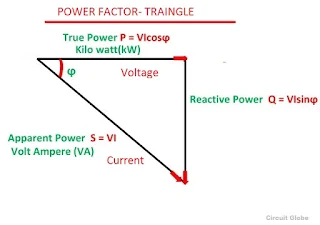Power Factor
The power factor is an important aspect of the power system. A low power factor results in low efficiency of the electrical system. To understand the related terms and how it can be calculated, the following details are provided:
a) KW: KW represents Working Power, also known as Actual Power, Active Power, or Real Power. It is the power that actually powers the equipment and performs useful work.
b) KVAR: KVAR represents Reactive Power. It is the power required by magnetic equipment (such as transformers, motors, and relays) to produce the magnetizing flux.
c) KVA: KVA represents Apparent Power. It is the vectorial summation of KVAR and KW.
POWER FACTOR
The power factor (P.F.) is the ratio of Working Power to Apparent Power.
P.F. = KW / KVA
Example:
Consider a single-phase induction motor. If the motor presented a purely resistive load to the supply, the current flowing would be in-phase with the voltage. However, in reality, the motor has a magnet, and the magnetizing current is not in phase with the voltage. The magnetizing current establishes the flux in the iron and, being out of phase, causes the motor shaft to rotate. The magnetizing current is independent of the load on the motor and typically ranges between 20% and 60% of the rated full load current of the motor. The magnetizing current does not contribute to the work output of the motor.
For example, consider a motor with a current draw of 10 Amps and a power factor of 0.75. The useful current is 7.5 A, and the useful power from the motor is 230 × 7.5 = 1.725 kW. However, the total power that needs to be supplied is 230 × 10 = 2.3 kVA. Without power factor correction, to achieve the required output of 1.725 kW (7.5 A), a power of 2.3 kVA (10 A) needs to be supplied. In this case, a current of 10 A is flowing, but only 7.5 A of that current is producing useful output.
The power factor can be expressed in two ways:
- Power factor (pf) = Useful power (kW) divided by the total power (kVA)
- Power factor (pf) = The cosine of the angle between useful power and total power (cos ø)
Power factor correction
Power factor correction refers to the technology used to restore the power factor to as close to unity (1) as economically viable. This is typically achieved by adding capacitors to the electrical network, which compensate for the reactive power demand of inductive loads and reduce the burden on the power supply. The operation of the equipment should not be affected.
To reduce losses in the distribution system and decrease electricity bills, power factor correction is implemented by adding capacitors to neutralize as much of the magnetizing current as possible. Capacitors in power factor correction equipment draw current that leads the voltage, resulting in a leading power factor. If capacitors are connected to a circuit that operates at a lagging power factor below 0.9, for example, some utility companies penalize consumers with poor power factor. Although there are various methods for metering this, the ultimate goal is to reduce wasted energy in the distribution system, thereby encouraging consumers to apply power factor correction. Most network operating companies now penalize power factors below 0.95 or 0.9.
Why improve power factor?
Improving power factor provides several benefits, including:
1. Environmental benefit: Reduction in power consumption due to improved energy efficiency, leading to fewer greenhouse gas emissions and less depletion of fossil fuels by power stations.
2. Reduction of electricity bills.
3. Extra kVA available from the existing power supply.
4. Reduction of I2R losses in transformers and distribution equipment.
5. Reduction of voltage drop in long cables.
6. Extended equipment life: Reduced electrical burden on cables and electrical components.
How to improve power factor?
Power factor correction can be achieved by adding capacitors in parallel with the connected motor or lighting circuits. It can be implemented at the equipment level, distribution board, or at the origin of the installation.

